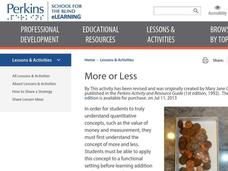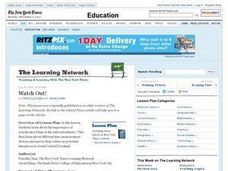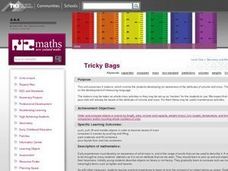Illustrative Mathematics
Longer and Heavier? Shorter and Heavier?
For many young children it seems obvious that longer objects are heavier than shorter objects. This assumption is put to the test as the class investigates the relationship between length and weight in a whole-group activity. Using a...
Illustrative Mathematics
Which Weighs More? Which Weighs Less?
Expand the the comparative language of young mathematicians with a hand-on weight measurement activity. Working independently or in pairs, children compare the weight of large wooden blocks to various other classroom objects, recording...
Curated OER
Comparing Objects
In this measurements worksheet, students practice the skill of choosing objects that are larger, smaller, taller, heavier and/or lighter than other objects. Students choose the multiple choice answer that best answers 7 questions.
Curated OER
Comparing
Practice the comparison words lighter, heavier, longer, shorter, smaller, and bigger using this visual chart. For each set of three objects, pupils order them according to one of these terms. The six terms are illustrated...
Curated OER
Friction 1
In this friction activity, students test heavy and light objects to see if the more friction of the heavier object makes it easy or harder for it to slide. Students also answer 5 questions.
Curated OER
Which is Heavier?
In this heaviest object worksheet, students check the object in a set of 2 that is the heaviest, 6 sets total. Answers are included on page 2.
Curated OER
Weight: Heavy or Light Worksheet
Which is heavier, a ladybug or a ship? Learners will have fun with this weight comparison worksheet, that uses visuals to help them determine which is heavier or lighter. They complete two comparisons for each. Lastly, they examine four...
Curated OER
Science: Objects That Rotate with Gravity
Students conduct experiments in gravity by rolling objects down an incline and determining which ones roll slower than others. As part of the experiment, they design objects which will roll the slowest. Using digital movie cameras or...
Perkins School for the Blind
More or Less
The concept of more or less is one that needs to be mastered prior to learning other concepts such as quantitative analysis, addition, or subtraction. This activity provides several ways to teach learners with low or no vision to...
Curated OER
Compare Weight
In this weight comparisons worksheet, students circle the picture of the heavier object in each set. Students underline the picture for the lighter object. Students finish by drawing items on the balance that have the same weight.
Curated OER
Comparing and Ordering Numbers
Students compare, order, and measure objects. In this measurement lesson, students are assessed on their ability to order, compare, and measure objects. This is an assessment only lesson and does not include instruction.
NASA
Newton Car
If a car gets heavier, it goes farther? By running an activity several times, teams experience Newton's Second Law of Motion. The teams vary the amount of weight they catapult off a wooden block car and record the distance the...
Curated OER
Pounds
For this mathematics worksheet, 1st graders identify which items pictured weighs more or less than a pound. Then they circle the objects that weigh more and place an X on the object that weigh less than a pound.
Curated OER
Density - An Introduction
Students experiment with objects of different densities. In this density lesson, students examine same-sized objects with different weights, then look at a teacher explanation of density. Students make wave bottles and a density jar to...
Curated OER
Watch Out!
First graders experiment with different sized balls and an incline plane to study how a heavy object push a lighter object. They examine the safety message of this instructional activity by showing their drawings of the crossbuck sign.
Curated OER
WS 5.6 Graham's Law
In this gases worksheet, students use the concepts of Graham's Law of diffusion to determine the velocity of gases and molecules. They describe kinetic energy and how it relates to the mass and velocity of objects.
Curated OER
Gravity Gets You Down
Students design an experiment to investigate how objects with different masses fall. In this physics lesson, students predict how these objects will fall in a vacuum tube. They write a report explaining experimental results and conclusion.
Curated OER
The Magic School Bus Gains Weight
Students learn along with Ms. Frizzle's class. For this Magic School Bus lesson plan, students test whether gravity makes heavier things fall faster than lighter ones.
Curated OER
Volume and Mass: Identify the Attribute
Young scholars rotate through five studying stations related to the attributes of volume and mass. They manipulate objects to explore mass, compare two masses by pushing and lifting, pack materials and fill containers, and pour liquids...
Curated OER
Density Lab Activities
Pupils participate in several density lab activities in order to clarify the misconceptions that solids sink and liquids float. Students work with triple beam balances to find mass of objects to calculate density.
Curated OER
Force: Push and Pull
In this force instructional activity, students answer short answer questions about pushing and pulling different objects. Students complete 15 questions.
Curated OER
Catapults!
Learners work together to discover the relationship between the angle of catapults and the flight of different objects. They discover the heavier the object the more force is needed. They examine how engineers use this information to...
Curated OER
Seesaws
Students make direct comparisons between objects using balance and spring scales. They also are encouraged to estimate which object is heavier by holding the objects before using the balance scales. Comparing the masses of objects is the...
Curated OER
Mass
Students determine how mass is a property of an object that can be measured, and examine how size affects mass. They work with balances and determine what units of measurement are associated with mass. Finally, they determine the...























